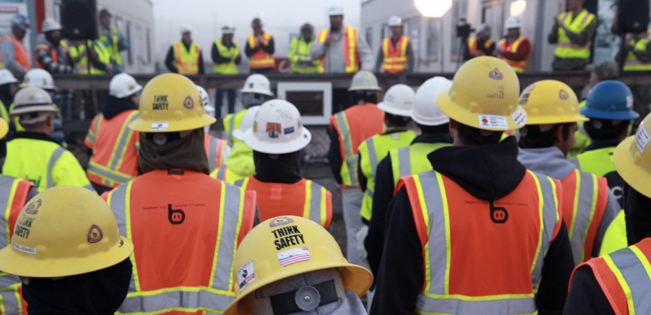All You Need To Know About Elevated Work Platforms
Do you work in an environment that requires you to be on elevated work platforms? Elevated work platforms are also referred to as aerial lifts. Aerial lifts include machinery such as scissor lifts, boom lifts, bucket-trucks, cherry pickers, and other mobile elevating equipment. If you're looking for any information on elevated work platforms you can find it here. Do you have more questions about aerial lift training or health & safety training in Ontario? Contact the experts at ACUTE today and we'll be happy to help!
Looking for training courses?
What Are Elevated Work Platforms?
An aerial work platform (AWP), also known as an elevated work platform (EWP) is a mechanical device used to provide temporary access for people or equipment to inaccessible areas, usually at heights.
Main Uses: Construction Projects

There are specific training requirements for using an EWP on construction projects to help ensure the safety of all workers involved.
- Employers must ensure that workers complete a CPO-approved Working At Heights training course delivered by a CPO-approved trainer. Employers must keep a record of completed training, and be willing to provide records to an inspector if needed.
- (Section 26.2 (1) of O. Reg. 213/91): Employers must ensure that workers who use fall protection equipment are adequately trained to use fall protection equipment. Workers must be given adequate oral and written instructions provided by a competent person.
- (Section 147(1) of O. Reg. 213/91): Before workers use EWPs, they must be given adequate oral and written instruction on how to properly operate the machinery. They must also be trained to operate the specific class of EWP they will be using in the workplace.
- (Section 147(2) of O. Reg. 213/91): Elevating work platform training must include:
> The manufacturer's instructions
> Instructions regarding load limitations
> Instructions regarding proper use of all controls AND a hands-on demonstration
> Instructions regarding limitations regarding the kinds of surfaces the EWP is designed to be used on. - Training should also include information about the specific workplace hazards workers may face and an evaluated demonstration by the worker showing safe operation skills.
Source – Ontario Ministry of Labour, Immigration, Training and Skills Development
Elevated Work Platform Certification
Some safety training courses receive government certification/approval. This is the case for the MLITSD required Working At Heights training course. Completing a certified Working At Heights training course is legally required for those working from heights on construction projects.
ACUTE's Working At Heights training program has been approved by the Chief Prevention Officer under the Ministry of Labour, Immigration, Training and Skills Development's Working At Heights Training Program Standard and the Working At Heights Training Provider Standard. Working At Heights training is valid for three years, and then refresher training is required.
"The Occupational Health and Safety Awareness and Training Regulation (O. Reg. 297/13) requires that employers ensure that workers on construction projects successfully complete a working at heights training program if those workers are required by the Construction Projects Regulation to use specified methods of fall protection (travel restraint system, fall restricting system, fall arrest system, safety net, work belt, or safety belt).
The program must be approved by the Chief Prevention Officer (CPO) and must be delivered by a training provider approved by the CPO (sections 6 and 7 of O. Reg.297/13). Employers must also keep a record of the working at heights training and make it available to an inspector on request (section 10 of O. Reg. 297/13)."
Unlike Working At Heights (WAH) training, elevated work platform training does not require the same certification. There is also no official expiry for elevated work platform training. For best safety practices, it is recommended that workers receive elevated work platform training or refresher training every year to ensure the safety of workers, employers, supervisors, and everyone else in the workplace.
However, there are different certification requirements and obligations for elevated work platforms under the OHSA and the Construction Projects Regulation.
It states:
"The elevating work platform must comply with the applicable National Standard of Canada as set out in O. Reg. 213/91. A professional engineer must have certified in writing that the elevating work platform is in compliance with the applicable National Standard. The certificate provided by the professional engineer must include the details of testing carried out on the elevating work platform and outlined in the standard [O. Reg. 213/91, section 144]."
Unlike WAH training, companies cannot be MLITSD certified specifically for elevating work platform training. Still, there are many specific requirements outlined by the MLITSD and OHSA to ensure workers are properly trained.

Specific Training Requirements For Elevated Work Platforms
There are different training requirements outlined by the MLITSD depending on the nature of the work. There are specific rules and regulations for those working in industrial establishments, as well as specific rules and regulations for those working on construction projects.
General Training Requirements
- Those operating EWPs must be provided with the appropriate information and instruction regarding how to safely operate the specific class of EWP they will be using in the workplace. Training should also include the manufacturer’s instructions.
- In order to ensure competence and safe work practices, periodic refresher training is highly recommended.
- When a worker completes training, they will receive proof of training. Workers should keep a copy of this proof of training on their person or at an accessible location in the workplace.
- Employers should also keep a record of operator and employee training in the workplace.
Source – Ontario Ministry of Labour, Immigration, Training and Skills Development
Elevated Work Platform Training – Why Hands-On Is Better

Hands-on training provides real-life practice and workplace simulation that online training cannot. Working with real EWPs in a safe environment with highly experienced professional trainers is the best way to prepare workers for real-world situations.
Proper, hands-on training is essential when learning how to protect yourself from and prevent potential risks and hazards. Online training cannot adequately help workers learn how to avoid and respond to potential hazards when on the job. EWPs qualify as heavy machinery and can be potentially deadly when misused. Some hazards include:
- Being struck by moving equipment
- Getting crushed between equipment or other objects
- Exposure to electrical contact while operating a vehicle or equipment
- Being struck by an inadequately secured load while being lifted or moved
- Being struck or crushed by equipment tipping over
- Source – Ontario construction sector plan 2017-2018
Interacting with experienced trainers, working with equipment, and learning how to react if a dangerous situation arises, are features available only from hands-on training. Sitting at home in front of a computer reading words on a screen can only prepare you for so much. Here are some more reasons why hands-on training is the best choice for EWP training.
- Collaboration – When you choose classroom training over online training, you get to work with others in a collaborative environment. When students are given opportunities to interact, they often come out with a more well-rounded and deeper appreciation of the knowledge being transmitted.
- Audience Engagement – If something goes wrong online, like poor sound quality or an improperly explained concept, there is not much the participant can do about it. With hands-on training, professional trainers have the ability to manage audience engagement. Hands-on training allows instructors to slow down and explain or speed up as necessary.
- Interactive Sessions – Interactive question & answer opportunities can help round out an employee’s learning experience and clarify any misunderstandings. Listening to other participants’ questions may even help answer a question you didn’t know you had!
- Practice & Simulation – As mentioned above, practice and simulation can go a long way! A reflexive mechanism is reinforced when intellectual and applied learning inform one another. This helps to ensure that the learned content is not only cognitively stored but actively used! It even becomes part of an employee’s instinctive behaviour.
Elevated Work Platform Training – Training With ACUTE

ACUTE offers multiple hands-on Elevating Work Platform training courses to suit your workplace’s specific needs. For example, some upcoming EWP courses include scissor & boom training or scissor lift only training. We also understand the convenience that online training offers. At ACUTE, we aim to accommodate all of our clients. That’s why you can choose to complete EWP training at your own facility! If you have a large group of workers who require EWP training or have specific scheduling/location needs, training at your own facility could be the right choice for you. Contact ACUTE today to find out more!
ACUTE’s Elevating Work Platform training has been constructed to prepare operators for the safe use of EWPs. The theory module covers all classes of EWPs, while the practical module covers only the type of EWP used in the participant’s workplace.
The course is one day long (8 hours) and will include:
- Training on hazards & safe work practices
- Training on legislation & standards
- Training on platform stability
- Training on class-specific skill testing
- Training on safe operating procedures
- Demonstration and hands-on training on relevant class of EWP
- Practical skills testing evaluation
- Classroom interaction with experienced instructors
- And More!
Ready To Get Hands-On EWP Training?
Help Create A Safer Workplace – Trust ACUTE!
Though online training may at first seem like a good choice, working with a qualified and experienced training company is the best way to ensure you and your workers stay safe in the workplace.
ACUTE helps organizations understand their training challenges while also providing unparalleled tailoring and customer service. Here are just a few things you can expect when training with ACUTE:

- Open Door Instructor-Student Partnership – ACUTE’s training services emphasize client participation. Staff want to build relationships with clients and serve as a touchstone for advice anytime moving forward.
- Serving Your Team and Industry – With a vast array of clients in manufacturing, construction, health, academic, and government agencies, ACUTE brings the best safety practices from across the spectrum to your workplace.
- 100 Years Combined Experience – ACUTE provides comprehensive health and safety training, on-site safety services, and consulting services. With over 100 years of combined experience, our staff offer more than theoretical or abstract ideas. ACUTE offers solutions.
- Track Record of Success – ACUTE is rated 4.9/5 stars on Google reviews, demonstrating a commitment to our clients, quality, and passion for training.
ACUTE is located in Waterloo, Ontario and services customers from the cities such as Toronto, Mississauga, Brampton, Hamilton, Milton, Kitchener, London, Guelph, and other cities from across Ontario.
“We have used Acute Environmental & Safety Services Inc. for many years and our personnel always come back well trained, energized and bringing lots of ideas. They are provided with substantial and in-depth knowledge together with challenging opportunities to put into practice what they have learned into our field operations.”
– Dante, Environmental Service Company – Read More Testimonials Here!



